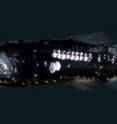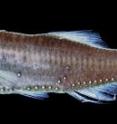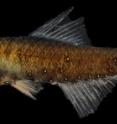Distinctive flashing patterns might facilitate fish mating
Scientists have shown for the first time that deep-sea fishes that use bioluminescence for communication are diversifying into different species faster than other glowing fishes that use light for camouflage. The new research indicates that bioluminescence -- a phenomenon in which animals generate visible light through a chemical reaction -- could promote communication and mating in the open ocean, an environment with few barriers to reproduction. The study was recently published in the journal Marine Biology. "Bioluminescence is quite common in the deep sea, and many fishes inhabiting this region exhibit complex, species-specific patterns of light-producing structures," said John Sparks, a curator in the American Museum of Natural History's Department of Ichthyology and one of the co-authors on the study. "But we still have so much to learn about how these animals use bioluminescence -- for predation, camouflage, communication, or something else. This new work provides insight into how this phenomenon might have shaped present-day biodiversity in the deep open ocean."
Unlike on land, where rivers, mountain ranges, and other physical obstacles can genetically isolate animals from one another resulting in speciation events over time, in the deep open ocean there are few obvious physical barriers to reproduction and gene flow. This has traditionally been considered one of the reasons why there is a comparatively low level of fish species richness in the deep sea. For example, bristlemouths, which are among the most abundant vertebrates on Earth, are represented by only 21 species. But that's not the case for all fishes. Lanternfishes, which inhabit the same mid-water, or mesopelagic, area of the ocean, have diversified into more than 250 species.
"The comparison of lanternfishes and bristlemouths is ideal for studying speciation in the deep sea. Both bioluminescent groups are among the most abundant vertebrates on Earth and live in the same dark environment," said Matthew Davis, a research associate at the University of Kansas and the study's lead author. "The difference in species numbers between these two groups is striking. Both use bioluminescence for camouflage, but lanternfishes have evolved a suite of light organs that act as a beacon for communication, which our work suggests have had an incredible impact on their diversification in the deep sea."
To investigate, Sparks, Davis, and other scientists from the University of Kansas and Johnson County Community College reconstructed a tree of life for ray-finned fishes with a particular focus on the evolution of bioluminescence.
Many fishes emit light from organs called photophores that appear as luminous spots on the body. On lanternfishes, photophores are present ventrally along the belly, laterally on the flank and head, and on the tail. The researchers discovered that the common ancestor of lanternfishes most likely evolved this complex photophore system during the Late Cretaceous, between 73-104 million years ago.
The significance of the photophores on the underside of mesopelagic fishes has long been thought to provide camouflage against predators swimming below, helping them to blend in with any residual light shining down from the surface. But the function of photophores on the side of the body has been obscure, until now. Using mathematical techniques based on the anatomy of the fishes, the researchers determined that the lateral photophore patterns on certain lanternfish lineages are distinct enough to allow identification of individual species. This is not the case for photophores on the belly. Recent work has shown that lanternfishes are capable of seeing blue-green bioluminescence from up to about 100 feet away, supporting the idea that lateral photophores could be used for interspecific communication.
"In this study we have shown that deep-sea fishes that exhibit unique, species-specific bioluminescent organs, like lanternfishes and dragonfishes, also exhibit increased rates of diversification," said Leo Smith, an assistant curator of ichthyology at the University of Kansas and a co-author on the paper. "This suggests to us that bioluminescent signaling may be critical to diversification of fishes in the deep sea."
To further test this hypothesis, the researchers plan to record lanternfish flashing patterns using emerging technology, such as remotely operated vehicles outfitted with ultra low-light underwater cameras. Other tools that might assist in this type of research include the Exosuit, a next-generation, human-piloted atmospheric diving system now on display in the American Museum of Natural History's Irma and Paul Milstein Family Hall of Ocean Life through March 5, 2014.
Source: American Museum of Natural History
Other sources
- Fish bioluminescence: Distinctive flashing patterns might facilitate fish matingfrom Science DailyWed, 5 Mar 2014, 13:32:39 UTC
- Distinctive flashing patterns might facilitate fish matingfrom PhysorgTue, 4 Mar 2014, 15:31:15 UTC
- Red-Seeing Fish, Blue-Seeing Fish: Deep-Sea Vision Evolvesfrom Live ScienceTue, 4 Mar 2014, 15:30:44 UTC


